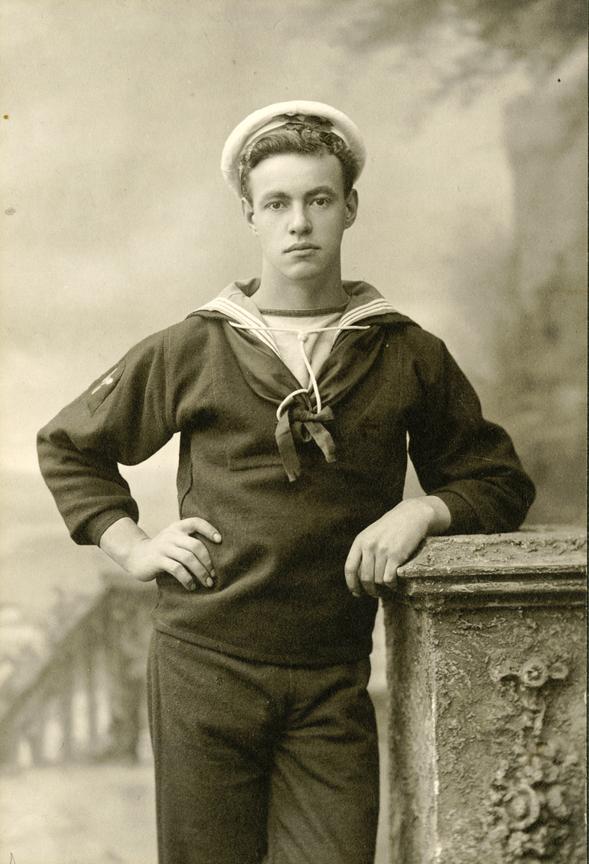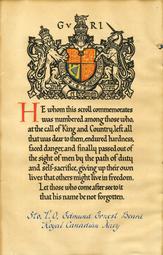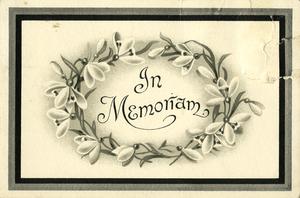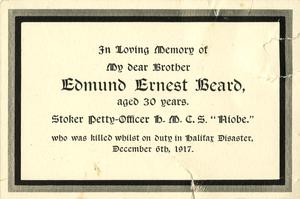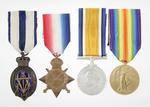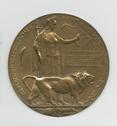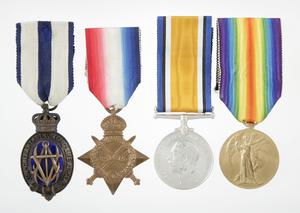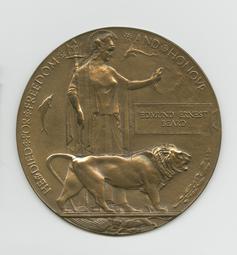Unit
HMCS Niobe
Branch
Service Component
Royal Naval Canadian Volunteer Reserve
Service Number
VR1731,SS101606
birth
1887/07/24
Hammersmith, London, United Kingdom, England
death
1917/12/06
Halifax, Nova Scotia, Canada
grave
Halifax Memorial (Panel 1), Halifax, Nova Scotia
Gender
Male
Ernest Edmund Beard was born in London, England, on 24 July 1887. He was the son of Frederick Beard, a carpenter, and Sarah Beard. The middle child of three, he was the Beards’ only son.
Beard joined the Royal Navy in 1905 (Service number SS101606). He received his initial training on the stokers’ training ship HMS Acheron (formerly armoured frigate HMS Northumberland) and was sent for further training at HMS Pembroke II shore establishment in Chatham. Once he completed training, Beard served on a number of ships as a stoker — including the armoured cruisers HMS Sutlej and HMS Minotaur, and the battleship HMS Magnificent — before transferring to the Royal Fleet Reserve in November 1910.
In 1911, Beard immigrated to Canada, arriving in Québec City, Quebec, on the Pomeranian on 10 October. He reacted to Britain’s declaration of war on Germany in early August 1914 by enlisting in the Royal Naval Canadian Volunteer Reserve on 11 August 1914 in Halifax, Nova Scotia. He was stationed on the HMCS Niobe with the rank of Stoker Petty Officer.
Beard was one of two Canadians awarded the Albert Medal for actions related to the Halifax explosion on 6 December 1917. The other was Acting Boatswain Albert Charles Mattison (Royal Canadian Navy). On that day, the French steamer Mont Blanc, with a cargo of high explosives, and the Norwegian steamer Imo collided in Halifax Harbour. Fire broke out on the Mont Blanc immediately after the collision, and the flames very quickly rose to a height of over 100 feet. The crew abandoned its ship and rowed towards the shore. Beard, Mattison and four other men from the HMCS Niobe volunteered to take a small boat from their ship and help the crew of the Mont Blanc fight the fire. However, just as they got alongside the Mont Blanc, it blew up, killing Beard and his crewmates. According to the Halifax explosion casualty register, their bodies were never recovered.
Both Mattison and Beard were awarded the Albert Medal for their bravery. Sadly for Beard, his name appears as “Edward S. Beard” on the medal and in the official announcement of the award in the London Gazette.
Beard’s service medals and Memorial Plaque were sent to his sister Evelyn in Belleville, Ontario. Evelyn had immigrated to Canada in 1913 and married Alexander Graham Dunn, an immigrant from Scotland, a year later.
Ernest Edmund Beard is commemorated on the Halifax Memorial (Panel 1) in Nova Scotia.
Albert Medal
"The King has been graciously pleased to approve of the posthumous award of the Albert Medal for gallantry in saving life at sea to: Mr. Albert Charles Mattison, late Acting Boatswain, Royal Canadian Navy, and Stoker Petty Officer Edward S. [sic] Beard, late Royal Naval Canadian Volunteer Reserve … On the 6th December, 1917, the French Steamer Mont Blanc, with a cargo of high explosives, and the Norwegian Steamer lmo were in a collision in Halifax Harbour. Fire broke out on the Mont Blanc immediately after the collision, and the flames very quickly rose to a height of over 100 feet. The crew abandoned their ship and pulled towards the shore. The commanding officer of H.M.C.S. Niobe, which was lying in the harbour, on perceiving what had happened, sent away a steam boat to see what could be done. Mr. Mattison and six men of the Royal Naval Canadian Volunteer Reserve volunteered to form the crew of this boat, but just as the boat got alongside the Mont Blanc the ship blew up, and Mr. Mattison and the whole of the boat's crew lost their lives. The boat's crew were fully aware of the desperate nature of the work they were engaged in, and by their gallantry and devotion to duty they sacrificed their lives in the endeavour to save the lives of others".

